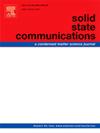Rectified electrical transport and self-powered photoresponse in ZnTe/WS2 heterostructures
IF 2.1
4区 物理与天体物理
Q3 PHYSICS, CONDENSED MATTER
引用次数: 0
Abstract
Semiconductor heterostructures have attracted widespread attention due to their applications in light-emitting diodes, solar cells, and photodetectors. In this work, a novel heterostructure consisting of ZnTe nanobelt and WS2 monolayer nanosheet was constructed by combining physical transfer with vapor deposition routes. The I-V curve of ZnTe/WS2 heterostructure device displays a rectification ratio of approximately 50, which can be attributed to the formation of PN junction. The derived photovoltaic effect enables self-powered photodetection. Additionally, light imaging measurements show that the achieved ZnTe/WS2 Photodetectors have good imaging capabilities under 405 nm light irradiation. These results reveal that such ZnTe/WS2 heterostructures are excellent candidates for optoelectronic applications.
求助全文
约1分钟内获得全文
求助全文
来源期刊

Solid State Communications
物理-物理:凝聚态物理
CiteScore
3.40
自引率
4.80%
发文量
287
审稿时长
51 days
期刊介绍:
Solid State Communications is an international medium for the publication of short communications and original research articles on significant developments in condensed matter science, giving scientists immediate access to important, recently completed work. The journal publishes original experimental and theoretical research on the physical and chemical properties of solids and other condensed systems and also on their preparation. The submission of manuscripts reporting research on the basic physics of materials science and devices, as well as of state-of-the-art microstructures and nanostructures, is encouraged.
A coherent quantitative treatment emphasizing new physics is expected rather than a simple accumulation of experimental data. Consistent with these aims, the short communications should be kept concise and short, usually not longer than six printed pages. The number of figures and tables should also be kept to a minimum. Solid State Communications now also welcomes original research articles without length restrictions.
The Fast-Track section of Solid State Communications is the venue for very rapid publication of short communications on significant developments in condensed matter science. The goal is to offer the broad condensed matter community quick and immediate access to publish recently completed papers in research areas that are rapidly evolving and in which there are developments with great potential impact.
 求助内容:
求助内容: 应助结果提醒方式:
应助结果提醒方式:


